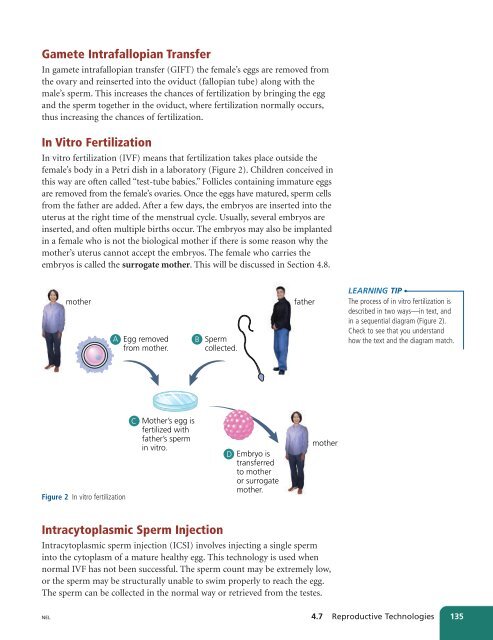Unit A Reproduction
Unit A Reproduction
Unit A Reproduction
You also want an ePaper? Increase the reach of your titles
YUMPU automatically turns print PDFs into web optimized ePapers that Google loves.
Gamete Intrafallopian Transfer<br />
In gamete intrafallopian transfer (GIFT) the female’s eggs are removed from<br />
the ovary and reinserted into the oviduct (fallopian tube) along with the<br />
male’s sperm. This increases the chances of fertilization by bringing the egg<br />
and the sperm together in the oviduct, where fertilization normally occurs,<br />
thus increasing the chances of fertilization.<br />
In Vitro Fertilization<br />
In vitro fertilization (IVF) means that fertilization takes place outside the<br />
female’s body in a Petri dish in a laboratory (Figure 2). Children conceived in<br />
this way are often called “test-tube babies.” Follicles containing immature eggs<br />
are removed from the female’s ovaries. Once the eggs have matured, sperm cells<br />
from the father are added. After a few days, the embryos are inserted into the<br />
uterus at the right time of the menstrual cycle. Usually, several embryos are<br />
inserted, and often multiple births occur. The embryos may also be implanted<br />
in a female who is not the biological mother if there is some reason why the<br />
mother’s uterus cannot accept the embryos. The female who carries the<br />
embryos is called the surrogate mother. This will be discussed in Section 4.8.<br />
mother<br />
A<br />
Egg removed<br />
from mother.<br />
B<br />
Sperm<br />
collected.<br />
father<br />
LEARNING TIP<br />
The process of in vitro fertilization is<br />
described in two ways—in text, and<br />
in a sequential diagram (Figure 2).<br />
Check to see that you understand<br />
how the text and the diagram match.<br />
Figure 2 In vitro fertilization<br />
C<br />
Mother’s egg is<br />
fertilized with<br />
father’s sperm<br />
in vitro.<br />
D<br />
Embryo is<br />
transferred<br />
to mother<br />
or surrogate<br />
mother.<br />
mother<br />
Intracytoplasmic Sperm Injection<br />
Intracytoplasmic sperm injection (ICSI) involves injecting a single sperm<br />
into the cytoplasm of a mature healthy egg. This technology is used when<br />
normal IVF has not been successful. The sperm count may be extremely low,<br />
or the sperm may be structurally unable to swim properly to reach the egg.<br />
The sperm can be collected in the normal way or retrieved from the testes.<br />
NEL<br />
4.7 Reproductive Technologies<br />
135

















